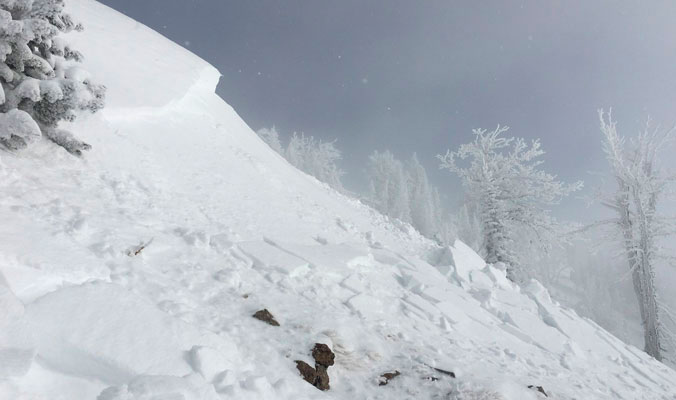
At this time of the winter, many forecast centers around the west are making note of a persistent problem and/or deep persistent slab avalanche problem in the forecast—a problem that, for some regions, has existed for multiple weeks or even months now. Understanding how to manage risk for these ongoing instabilities can be difficult; to better understand why these buried layers affect the snowpack for so long and why they appear in the first place, we must look back to the first snows of the season.
Where these problems begin:
When it snows in September, skiers and riders start rejoicing for the season to come. Snow and avalanche professionals, however, are often left wringing their hands. Why the different reactions?
Often, when we see snow in September, the skies eventually clear and fall returns for a few weeks or even a couple of months. With no new precipitation falling on an already shallow snowpack, the scant autumn snow starts to disappear or to facet. From the moment that snow falls from the sky, it is changing—it can strengthen and it can weaken—and this metamorphosis is a season-long process that continues until those snowflakes end up in the river come spring.
As a rule of thumb, shallow snow is weak snow. This is why snow and avalanche professionals start sounding the alarm bells when we see that early season snow: it can can sit around and weaken on the cold, shady aspects of the mountains until winter truly kicks in. This weakening process, dubbed faceting, occurs when shallow snow and cold temperatures combine. Fallen snow changes into angular crystals that don’t stick together—identifiable by its sugar-like consistency. When you scoop facets up, they don’t form a good snowball, instead bouncing and scattering on your glove.
If snow comes to your area early and then just sits around, the mountains are forming a weak foundation for the season’s snowfall. When winter finally shows up in earnest, the snow is falling on a weak base structure—consider it like trying to build a house on a foundation of sand. As this persistent weak layer gets buried, a persistent slab avalanche problem can start to develop. Often this buried weak layer takes a long time to strengthen, so it remains in the forecast for a long period of time.
What is there to do about early season facets?
1. When you hear your local forecasters warning of early season snowfall and the problems it might create, start taking pictures. Where does this early season snow stick around? Where does it melt? Gathering this information can help you when winter finally kicks into gear. You will have a working hypothesis on where you may find a strong foundation, or, by contrast, where you may find a problematic base layer.
2. When you travel in the backcountry, always ask yourself, “Do we have a recipe for an avalanche? Is there a slab, weak layer and bed surface present? Are we traveling in terrain that is steep enough to avalanche?” I ask myself these questions all day, every day when I’m touring. If I do have a recipe for an avalanche, I’m going to take the time to get my shovel out and test that snowpack to see how it reacts. If you don’t have the time or the knowledge to do that, you should avoid traveling in avalanche terrain.
3. Check the avalanche forecast. Take the time to read not just the hazard rating, but also the current avalanche problems. If early season snow has been buried, you will likely read about a persistent slab problem or deep persistent slab problem. These avalanche problems are hard to predict and hard to manage. If you see them in the forecast, consider dialing back your terrain choices.
Bottom Line:
How is a perfect snowpack for a great season of skiing and riding made? It’s made in those years when it starts snowing in mid-November (ish) and it doesn’t stop; it’s made in the years when there is consistent snowfall throughout the winter—not huge snowfall totals overnight and not long periods between storms. Gradual, consistent loading primes the snowpack: strong, hard snow at the bottom and softer snow as you reach the surface.
When perfect doesn’t appear, take pictures to track where the early season snow sticks around and where it melts. As the season progresses, pay attention to what the forecast center is telling you—is that persistent slab still a problem? What is the likelihood of triggering it and where is it located? Have there been recent avalanches on this layer? Some years the weak foundation proves to be a problem for a long period of time and some years it doesn’t.
As mid-season approaches, pay attention to the outlier avalanches—those slides that go bigger and deeper than anyone expected—that could be the indication that there is enough of a load on that weak foundation to tip the scales.










Related posts: